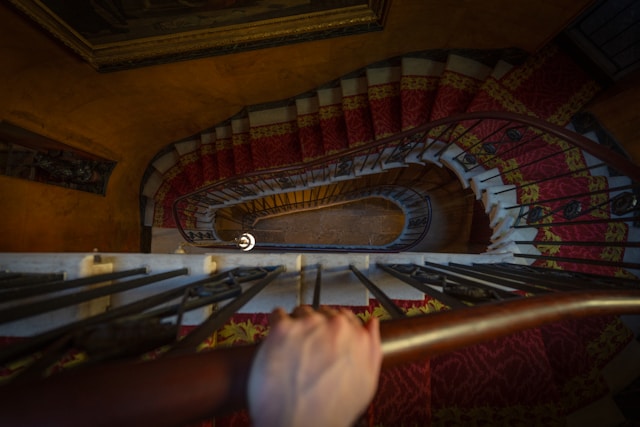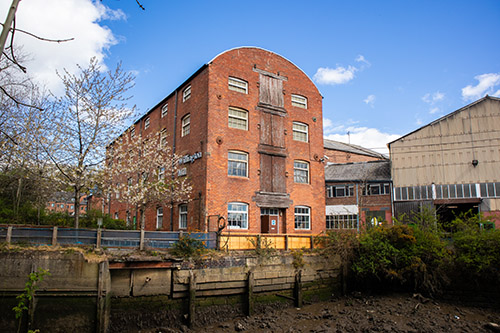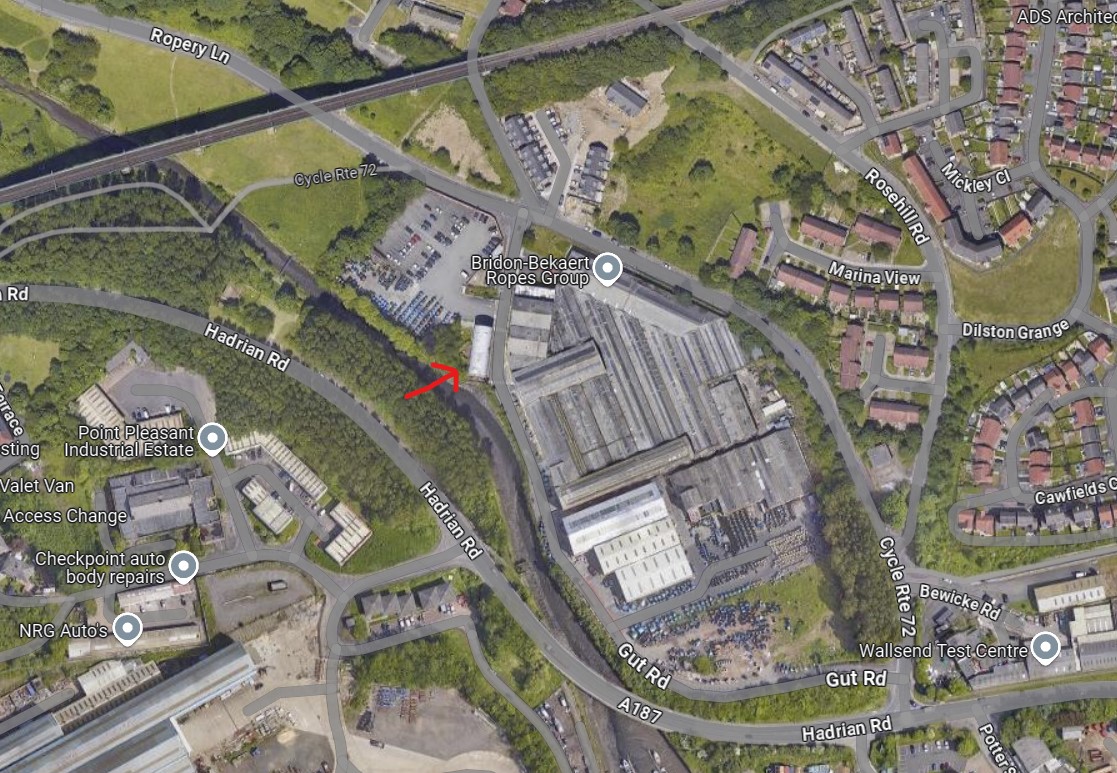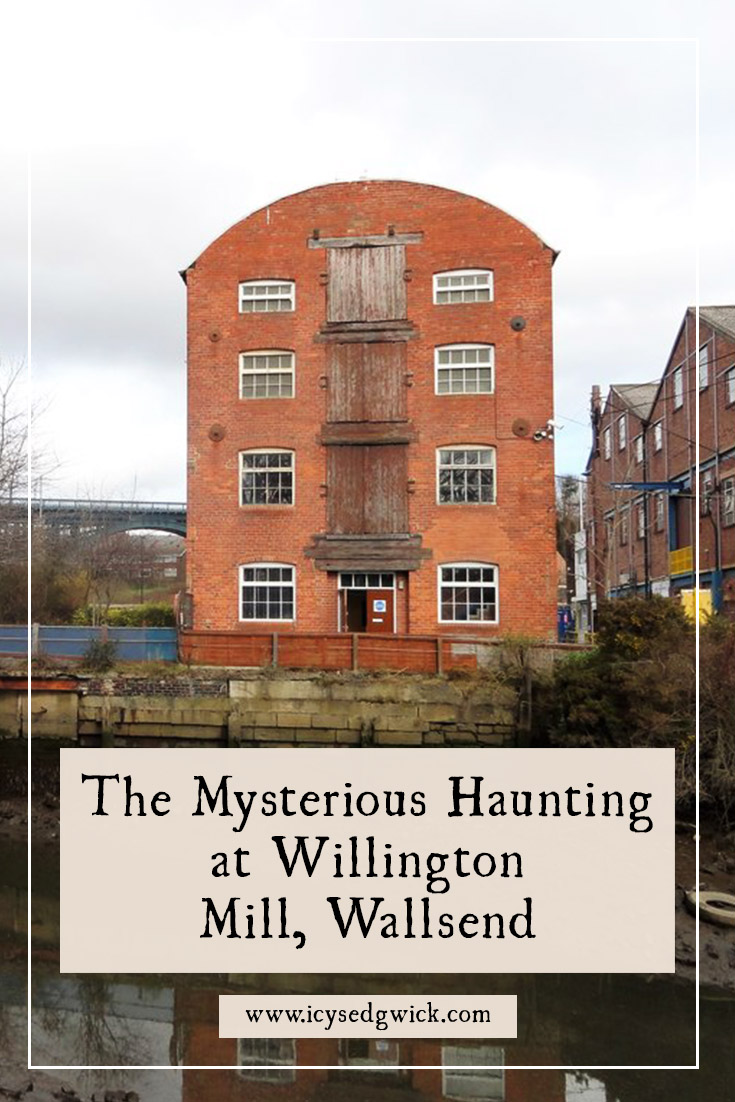We might think of ghost hunts or investigations as a predominantly 20th and 21st-century endeavour. Yet the legend of the ghosts at Willington Mill shows that people were trying to unearth the supernatural even in the first half of the 19th century.
Spectral figures and unearthly noises plagued those living at the miller’s house, with witnesses even seeing the ghosts from the street. Despite the fascinating tales of haunting reported by people who visited the house, it’s the story of the midnight vigil that has become more famous.
So let’s explore the tale of the haunting of Willington Mill, and try to sort some fact from fiction.
The Background
Willington lay between Wallsend and North Shields; it gives its name to the current area of Willington Quay. The site we’re looking at is slightly further west, beside the narrow stream of Willington Gut that empties into the River Tyne. The site was home to a mill, the miller’s house, and a collection of other buildings. The steam mill was seven storeys high, and the north east’s first steam-powered mill.
The miller’s house was surprisingly grand, boasting 12 or 13 rooms and attics across three storeys. Built in 1806, the hauntings took place between 1840 and 1845. George Unthank originally owned the flour mill, but Quaker Joseph Procter became a partner in the business in 1829. Procter and his family took up residence in the house.
The Unthanks reported no supernatural activity, though local rumours persisted that the house must be haunted. The Procters lived there for twelve years before anything weird happened. Rumours abounded of a murder during the original building work on the house, carried out by a builder.
A newspaper article in 2013 claimed that a local legend spoke of Kitty, a worker whose hair became caught in a millstone and she died minutes later. This legend apparently cites Kitty as the ghost haunting the mill (Wearmouth 2013). Yet people more often discuss the ghosts haunting the house.
So what were these ghosts?
Ghosts at Willington Mill
One of the ghosts was a bare-headed man in a surplice, seen by four witnesses at an upper window. Visible for ten minutes, he drifted back and forth with his feet level with the bottom of the second-floor window. The witnesses described the figure as “semi-transparent, and as bright as a star, diffusing a radiance all around. As it grew more dim, it assumed a blue tinge, and gradually faded away from the head downwards” (The Shields Daily News 1887: 3).
One of the witnesses, the foreman, tried to examine the scene from under the window, and went to report the apparition to the family. The house was locked up for the night, and the account stressed a lack of moonlight to cause the phenomenon (The Shields Daily News 1887: 3). The phantom priest gained the nickname ‘Old Jeffrey’. Was he the person murdered by the builder during the house’s construction?
Or was the victim the woman in a lavender dress?
Some reports describe her dress as grey, and she’s most notable for her lack of eyeballs. It seems she stared at witnesses with empty sockets. People sometimes saw her sitting wearing a mantle, with her hands in her lap and her head bowed (Dalston 1891: 117).
It seems a clairvoyant visited the mill, and she described Old Jeffrey and the Grey Lady. According to her, the Grey Lady tried to confess a deadly crime committed on the site many years earlier, but the priest refused to hear her confession (The Shields Daily News 1887: 3). While this might explain the Grey Lady’s continued presence in the area, it doesn’t quite explain Old Jeffrey.
People also reported hearing thumping against the floor, someone coughing or groaning in empty rooms, and small feet pattering around an upstairs room. One rumour concerning Mr Procter claimed he’d found an old book about a house on the site two centuries earlier, which also suffered the same haunting (Dalston 1891: 117). This is difficult to substantiate, but it also negates the rumour of a murder during construction of the house.
Three Nights of Hauntings
Two cousins of Joseph Procter came to stay, and shared a bedroom. On the first night of their stay, the bed rose up from the floor with the two women on it. They raised the alarm, fearing burglars rather than phantoms, but a search of the house revealed nothing.
The second night saw the bed shaken and the curtains opened and closed.
On the third night, the women removed the curtains so they could observe any happenings. They probably wished they hadn’t as a female figure, insubstantial as mist, drifted through the wall. Glowing with a blue hue, she floated above them, grinning down at them, before disappearing. Unsurprisingly, Procter shut up the room and no one slept in it again (Reynolds 1990: 40).
Noises on the Stairs
One of Mrs Procter’s brothers, described as “a person apparently most unlikely to be imposed on by fictitious alarms of tricks”, seemed to endure a bizarre event at the house (Dalston 1891: 117). Having already heard strange noises on one visit to the house, a second haunting also occurred while he stayed the night.
He lay in bed and heard heavy footsteps coming up the stairs. It sounded as though someone thumped the bannisters with a heavy stick on the way up. The sound came to his door, so he sprang out of bed and threw open the door. The landing was empty, yet he now heard the same footsteps going down the stairs. The stairs themselves looked empty, although the heavy tread and banging on the bannisters continued.

He woke Mr Procter and they searched the house but found nothing that might have been causing the sounds (Dalston 1891: 117). No one knew of any passages under the house that might be the source of any noises. Many accounts also stress that the house “is quite detached from the mill or any other premises”, also discounting a possible logical explanation for the events (Dalston 1891: 117). Yet this quest to find the root cause of the haunting is what makes the case so fascinating.
The Investigation
The stories of the haunting spread, and caught the attention of Dr Edward Drury. He’d read about the supernatural in the writings of John Wesley. He wrote to Procter, asking if he could mount a vigil in the house to get to the bottom of the events. While Procter warned Drury that activity was sporadic at best, he agreed to some kind of investigation (Shields Daily News 1887: 3).
Eventually, the vigil took place on 3 July 1840. Drury brought Thomas Hudson with him, a chemist from North Shields. They double-checked the whole house, and satisfied that it was shut up for the night, took up their post on the third-floor landing, facing the most haunted rooms. Only Drury, Hudson, Procter, and Procter’s servant were inside the house.
At this point, it’s best to simply reproduce the letter Drury wrote to Procter. He appraised him of everything that happened during the vigil. It seems that, while Procter was on the premises at the time, Drury didn’t speak to him in person before he left the building.
The Letter
“DEAR SIR,
I hereby, according to promise in my last letter, forward you a true account of what I saw and heard at your house, in which I was led to pass the night from various rumours circulated by most respectable parties, particularly from an account by my esteemed friend, Mr Davison, whose name I mentioned to you in a former letter. Having received your sanction to visit your mysterious dwelling, I went, on the 3rd of July, accompanied by a friend of mine, T. Hudson. This was not according to promise, nor in accordance with my first intent, as I wrote you I would come alone; but I felt gratified at your kindness in not alluding to the liberty I had taken, as it ultimately proved for the best.
I must here mention that, not expecting you at home, I had in my pocket a brace of pistols, determining in my mind to let one of them drop before the miller, as if by accident, for fear as should presume to play tricks upon me; but after my interview with you, I felt there was no occasion for weapons, and did not load them, after you had allowed us to inspect as minutely as we pleased every portion of the house. I sat down on the third-story landing, fully expecting to account for any noises that I might hear in a philosophical manner. This was about eleven o’clock p.m.
About ten minutes to twelve we both heard a noise, as if a number of people were pattering with their bare feet upon the floor, and yet, no singular was the noise, that I could not minutely determine from whence it proceeded. A few minutes afterwards we heard a noise, as if someone was knocking with his knuckles among our feet; this was followed by a hollow cough from the very room from which the apparition proceeded. The only noise after this was as if a person was rustling against the wall in coming up-stairs. At a quarter to one, I told my friend that, feeling a little cold, I would like to go to bed, as we might hear the noise equally well there; he replied he would not go to bed till daylight.
I took up a note which I had accidentally dropped, and began to read it, after which I took out my watch to ascertain the time and found that it wanted ten minutes to one. In taking my eyes from the watch they became riveted upon a closet door, which I distinctly saw open, and saw also the figure of a female attired in greyish garments, with the head inclining downwards and one hand pressed upon the chest as if in pain, and the other, viz., the right hand, extended towards the floor with the index finger pointing downwards. It advanced with an apparently cautious step across the floor towards me; immediately as it approached my friend, who was slumbering, its right hand was extended towards him.
I then rushed at it, giving, as Mr Procter states, a most awful yell; but, instead of grasping it, I fell upon my friend, and I recollect not distinctly for nearly three hours afterwards. I have since learnt that I was carried downstairs in an agony of fear and terror. I hereby certify that the above account is strictly true and correct in every respect.
“EDWARD DRURY.”
Hudson’s Evidence
Hudson later recalled Drury fainting in his arms, but admitted he personally saw nothing. It’s worth noting that in Hudson’s account, his governor in North Shields, Mr Ogilvie, asked him to accompany Dr Drury on the vigil to “see that he doesn’t come back with a cock-and-bull story about it” (Shields Evening News 1938: 4).
While Hudson ascribed many of the noises to normal causes, he did acknowledge a sound he couldn’t explain at 12:45 am. He said it sounded “as if someone were really there, walking on his (or her) bare feet, and approaching us. But nothing met our vision” (Shields Evening News 1938: 4). Apparently, Hudson and Drury then had a brief argument, having both been awake since 6 am the previous day, and Hudson started to doze off.
Moments later, Drury’s yell roused him, and Hudson described how “his hair [was] standing on end, the picture of horror” (Shields Evening News 1938: 4). Drury fainted at this point, and Hudson went to investigate in the room where he’d heard the footsteps. He found nothing.
Hudson also noted that Procter entertained the pair with stories of the hauntings over supper before the vigil. According to Hudson, Procter had never seen the ghost, though he’d heard plenty of sounds he couldn’t explain. His children had told him many tales of the apparition but seemed remarkably calm about it all. Their testimony, and his experiences of strange sounds, convinced Procter “that the story of the supernatural appearance in his house was founded on fact” (Shields Evening News 1938: 4).
The Afterlife of Willington Mill
The mill closed in 1865, though a chemical manure works bought the site in 1871. Procter warned the new owner about the ghost, though no ghost was apparently forthcoming. Procter turned the house into smaller tenements for workers, and some say the disturbances continued, albeit less often (Dalston 1891: 117). Eventually, the house succumbed to demolition, though I’d love to know if the occupants of the new housing development on Miller’s Bank have experienced anything strange.
Surprisingly, staff at Bridon-Bekaert, who currently use the site, have reported strange activity. One employee reported something pushing him in the back on a night shift. A manager reported the sensation of being watched. He’d also seen shapes and shadows on the property (Wearmouth 2013). We might account for this by separating supernatural activity at the mill and at the house, though frustratingly accounts refer to “the mill” and don’t always specify which part of the site they mean.
The attempts at investigation made at the time absolutely fascinate me about this case. From the foreman checking to see if anything rational had caused the appearance of Old Jeffrey to Dr Drury’s vigil, there seems to have been a concerted effort to find a logical explanation. While John Wesley’s writings on the supernatural drove Drury, many of the major players in the story seem devout skeptics. In many ways, this makes the story more interesting since no one really accepts what they experienced as supernatural until they’ve exhausted other avenues.
So who knows? Perhaps Willington Mill and the house really were haunted. Maybe the site still is…
Had you heard the story of the Ghosts of Willington Mill before? Or do you live nearby? What do you think?
References
Dalston, F.E.B. (1891), ‘Haunted Houses: The Ghosts of Willington Mill’, The Weekly Telegraph, 21 February, p. 117.
Reynolds, Hazel (1990), Ghosts and Legends of Northumbria, .
The Shields Daily News (1887), ‘Famous Ghost of a Willington Mill’, The Shields Daily News, 27 December, p. 3.
The Shields Evening News (1938), ‘Famous Ghost of a Willington Mill’, The Shields Evening News, 29 August, p. 4.
Wearmouth, Rachel (2013), ‘Willington Mill’s ghostly past explored in book’, Chronicle Live, https://www.chroniclelive.co.uk/news/north-east-news/willington-mills-ghostly-past-explored-1398669.
Nutty about folklore and want more?
Add your email below and get these posts in your inbox every week.
You'll also get my 5-step guide to protecting your home using folklore!









Wonderfully creepy.
That was a great episode – I love a good Northumbrian ghost story. This episode left me running down rabbit holes late into the evening! I immediately turned to the Monthly Chronicle of North Country Lore an Legend, where I found the Willington mill story in the June 1887 edition. Curiously it was already bookmarked with a clipping I must have cut from the Hexham Courant in the mid 1980s – an article on the haunting of Knaresdale Hall near Haltwhistle. In a typical South Tynedale farmer’s manner the owner of the farm “declares firmly that he does not believe in ghosts – although he has been in contact with it once!”. The Knaresdale ghost also appears in the 1891 Monthly Chronicle.
The Chronicle report on the Willington ghost runs to about 5 pages – but didn’t add much to your excellent account, it draws on all the same accounts that you used. I’m sure you have it too. It does provide a useful sketch of the mill and house made in 1887, which seems to suggest that the mill and house were very close together, unless it’s artistic licence, but possibly sound could travel between the two. As you say, it is very interesting that it provides a few accounts from very early ghost hunters and vigils – Messrs Drury and Hudson’s vigil in 1840 would have been prime Most Haunted stuff, Catherine Crowe’s Night Side of Nature was published a just few years later – so they seem to be really at the forefront of ghost hunting.
From Knaresdale I moved on to the ghosts of Haughton Castle, on North Tyne opposite Barrasford where I used to live. I remember well the story of the incarcerated border reiver haunting the place, but google brought up also a ghost of a burning man running across the fields, which I hadn’t heard before. One to look into a bit more.
Thanks again for bringing these stories back to life, looking forward to many more
Great episode, had me running down various rabbit holes for the rest of the evening. I immediately turned to the Monthly Chronicle of North Country Lore and Legend, among my first go-tos for this kind of story, and it appears in the June 1887 edition. I had clearly read it before since it was handily bookmarked with a cutting from the Hexham Courant which I must have clipped out in the mid 1980s. This was all about the ghost of Knaresdale Hall, near Haltwhistle. In the typical manner of a South Tynedale farmer the then owner “declares firmly that he does not believe in ghosts – although he has been in contact with it once!” The Knaresdale Hall story also appears in the Monthly Chronicle in 1891.
The Chronicle story on Willington Mill runs to about five pages, but adds nothing to your accounts, I would assume that you probably use this too, although it draws on many of the other sources that you reference; it also provides a sketch drawing of the mill and mill house made in 1887. It appears to show the house and mill as being very close together, unless this is down to artistic licence, but if so suggests that noise could travel easily from mill to house.
It is interesting, as you note, to read such early accounts of intrepid ghost vigils, Messrs Drury and Hudson’s account would have made a good Most Haunted episode. They seem to come from the beginning of the investigative era of ghost hunting, Catherine Crowe’s Night Side of Nature being published just a very few years later.
From Knaresdale I moved on to Haughton Castle, on the North Tyne by Barrasford where I used to live. I remember well the story of the incarcerated border reiver, but then google also threw up a story of a burning man seen running across the fields towards the castle from Barrasford (I assume he doesn’t get there because the river would get in his way). That was new to me, and one to look into some more And now as I write I remember a story one of my old landladies told me about the ghost she met at Brinkburn…
So thank you once again for bringing these fascinating Northumbrian ghost stories back to life, already looking forward to the next one and seeing where that leads me.